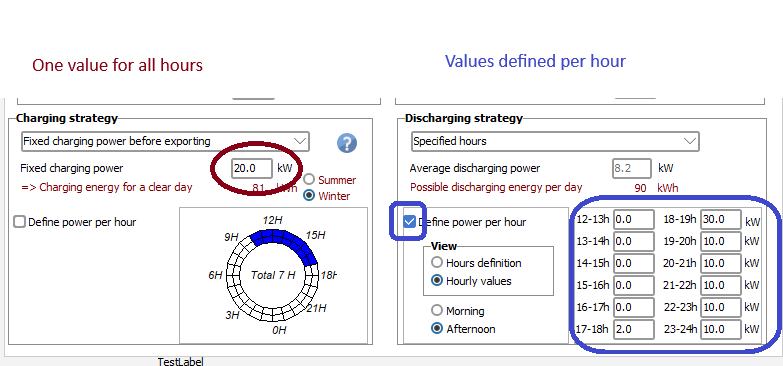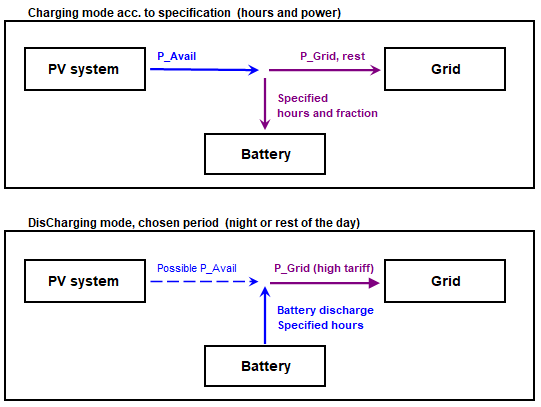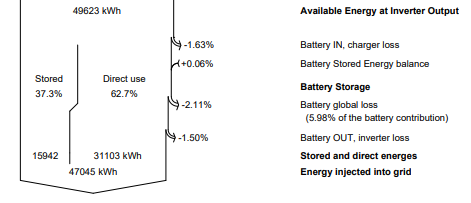Storage: Power shifting
This strategy consists in storing part of the available PV energy during the day and discharging it later during periods of higher electricity tariffs.
Principle
The user can specify charging conditions (charging hours, charging power or charging fraction of PV production) and discharging conditions (hours and discharging power). Discharging is typically scheduled during periods with higher tariffs, or when required by the grid operator. In this mode, no local (on-site) consumption is considered: the energy flows are comparable to those in the peak shaving strategy.
In systems subject to grid export limitations, power shifting can also act partially as a peak-shaving strategy: when PV generation exceeds the permitted injection, the surplus can be diverted to the battery. This approach designed for large-scale, utility-connected projects to optimize revenues. It does not currently support self-consumption in PVsyst, though this may be added in future versions if required. For the strategy to be economically viable, the cost of stored energy must be lower than the tariff differential between peak and off-peak hours.
Charging and Discharging Strategies
Three charging strategies are available and can be defined either on a daily or hourly basis:
- Fraction of the PV production: a fixed fraction of the available PV power is directed to the battery. Note that the fraction is applied to the expected Nominal EArray and not to EoutInv.
- Fixed charging power: the battery is charged at a constant power setpoint. Any remaining PV power, if available, is injected into the grid. If the PV production is lower than the setpoint, all generated energy is sent to the battery, but the target charging power will not be reached. Note that losses apply: when sending 50 kW to the battery, charging losses apply and the energy effectively stored is slightly less.
- Fixed grid export: a fixed power is injected into the grid, and any surplus PV energy is used to charge the battery. If PV production is lower than the fixed export setpoint, all energy is sent to the grid, but the target injection will not be reached.
The table below illustrates (no losses shown) how PV power is split between the battery and the grid for each strategy. This split assumes the battery can accept charge; when the battery is full, all surplus energy is sent to the grid. Note that the charge is also limited by the charger maximum charging power.
| PV Production [kW] | Fixed grid export: 100 kW | Fixed charging: 100 kW | Fraction: 40% | |||
|---|---|---|---|---|---|---|
| Grid [kW] | Battery [kW] | Grid [kW] | Battery [kW] | Grid [kW] | Battery [kW] | |
| 50 | 50 | 0 | 0 | 50 | 30 | 20 |
| 100 | 100 | 0 | 0 | 100 | 60 | 40 |
| 150 | 100 | 50 | 50 | 100 | 90 | 60 |
| 300 | 100 | 200 | 200 | 100 | 180 | 120 |
Note: The power shifting mode is compatible with grid limitations. The Fixed grid export strategy can be used as a peak shaving mechanism.
Two discharging strategies are defined to control when and how the battery releases stored energy.
- Specified hours: the battery discharges at a fixed power during the selected time slots. Different discharging powers can be assigned to different periods.
- During the night: the battery discharges overnight, with night hours determined from the weather data (.MET file) used in the simulation. During dusk/dawn hours, the battery will discharge during the corresponding fraction of hour after sunset.
Procedure and Sizing
- Define the charging conditions: Select the charging hours (or half-hours) and the strategy: either a fraction of the available PV production or a fixed power. Charging fractions or power levels may be set hour by hour. Sizing: PVsyst displays the expected charging energy on a clear summer or winter day, which provides a reference for sizing the battery pack.
- Define the discharging conditions: Similary, selct the discharging strategy, the discharging hours and the corresponding power, either fixed or variable by hour. Sizing: The possible discharging energy per day should be close to or greater than the charging energy to ensure full daily cycling.

- Battery pack definition: In the storage pack tab, select a battery model and define the number of cells/modules in series (operating voltage, to match charger/inverter requirements) and in parallel (storage capacity). Sizing: The battery size is determined by the desired daily energy shift, which is an economic choice. Optimization typically involves running multiple simulations to compare tariff differences (direct vs stored kWh over the battery lifetime) with the cost of the battery system. Because shifting is limited to daily cycles, the battery capacity should not exceed the maximum daily charging energy.
- Define the maximum charging power Once the storage pack is defined, specify the charger nominal power in the power shifting tab. The default is derived from the charging strategy for a clear day, limited by the battery’s maximum charging power. Oversizing should be avoided, as efficiency depends on the operating point relative to the efficiency curve. The maximum charging power should be higher than the power to be charged as losses occur during charge.
- Define the maximum discharging power Finally, specify the nominal output power of the battery inverter. The default value is based on the maximum discharging power from the strategy, limited by the battery’s maximum rating. The maximum discharging power should be higher than the power to be discharged to the grid as losses occur during discharge.
Grid limitation
Grid limitations (if any) should be applied at the injection point and not at the inverter level. If the battery is full and the grid limitation is reached, the lost energy will be accounted as EGridLim. Note that in the peak shaving strategy, this quantity is accounted as EUnused.
Simulation
The battery operates in daily cycles: it is discharged overnight and recharged during the day according to the chosen strategy.
After the simulation, the energy fluxes will be displayed in the loss diagram:
The diagram shows:
- Stored and Direct use: fraction of available energy stored in the battery.
- Battery global loss difference between charging and discharging energies (due to faradaic efficiency, internal resistance, self-discharge, or gassing in lead-acid batteries). This indicates the round-trip efficiency.
- CL_Chrg, CL_InvB: The charger and battery inverter's efficiency losses.
- Stored and direct energies: Energies at the grid injection level. This is the main result for tariff-based financial evaluation.
- E_Grid: total energy delivered to the grid.
Updates
- Added to PVsyst 8.0.17. Not compatible with self-consumption.

